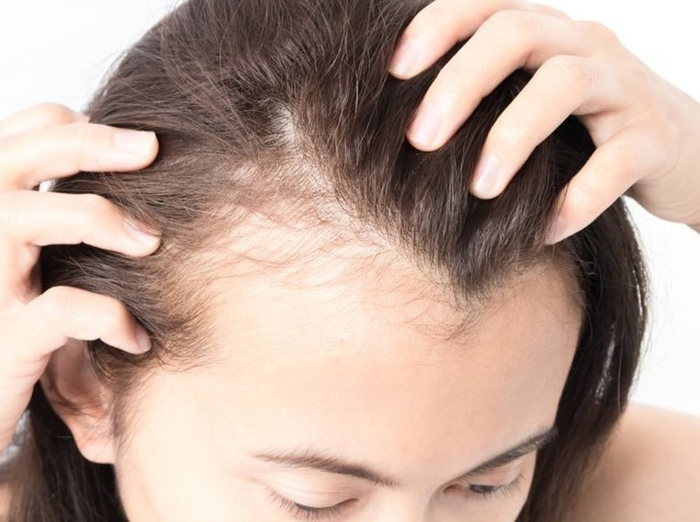
Androgenetic alopecia (AGA) is the common progressive balding that occurs through the combined effect of a genetic predisposition and the action of androgen on the hair follicles of the scalp. Pattern of hair loss in males varies from bitemporal recession, to frontal and/or vertex thinning, to loss of all hair except that along the occipital and temporal margins. In males, diffuse thinning occurs, worse centrally.
Causes of Androgenetic Alopecia
The mechanism of action of androgen on follicular cellular processes that results in AGA is unclear, but in most cases it is a local phenomenon (increased expression of androgen receptors, changes in androgen metabolism) of the scalp hair follicles. Consequently, most patients (male and female) are endocrinologically normal. Terminal follicles are transformed into vellus-like follicles, which in turn undergo atrophy. During successive follicular cycles, the hairs produced are of shorter length and of decreasing diameter. Conversely, androgens induce vellus-to-terminal follicle production of secondary sexual hair. Males castrated before or during puberty do not develop AGA despite a strong family history; administration of androgen can produce baldness that does not progress if the drug is withdrawn. Dihydrotestosterone, an intracellular hormone, causes growth of androgendependent hair (e.g., pubic, beard) and loss of non-androgen-dependent scalp hair. In males, testosterone produced by the testes is the major androgen. In females, androstenedione and dehydroepiandrosterone sulfate are the major peripheral androgens, and these two hormones are very slowly converted to dihydrotestosterone in the target cell (hair keratinocyte) by 5α-testosterone reductase. The serum testosterone levels in men are much higher than in women, and there are higher tissue levels and greater conversion to dihydrotestosterone.
Symptoms of Androgenetic Alopecia
In men, androgenetic alopecia is characterized by gradual hair thinning that most often affects the crown and frontal areas of the scalp. In many men, the hairline around the temples regresses. As it moves back to the midscalp, an M-shaped hair pattern develops. The hair in areas affected by hair loss may be of various lengths and thickness, and the presence of uneven lengths and texture is a classic sign of male pattern balding.
Women may have similar patterns of hair loss, although typically the hair loss is a little more diffuse than in men; women rarely experience loss of all their hair.
Diagnosis
Clinical diagnosis is made on the history, pattern of alopecia, and family incidence of AGA. Skin biopsy may be necessary in some cases.
Treatment
Oral Finasteride An oral prescription drug available in the United States, finasteride, at 1 mg/d, competitively inhibits type 2 5α-reductase and thus the conversion of testosterone to dihydrotestosterone; this results in lower serum and scalp levels of dihydrotestosterone. Finasteride has no affinity for androgen receptors and therefore does not block the important actions of testosterone cited previously (sex drive, growth of the phallus and scrotum, and spermatogenesis). Finasteride was developed to treat male pattern hair loss in two sites only: the vertex (at the top of the head) and the anterior mid-scalp area. It is now approved for use only in men. Finasteride has been proved to maintain or increase hair count in most men. In large double-blind clinical studies of men (18 to 41 years) with mild to moderate hair loss, hair count was maintained in those men taking finasteride, while men taking a placebo exhibited progressive hair loss. According to large clinical studies in 1850 men, finasteride starts immediately to block the formation of dihydrotestosterone, but because the hair is slow growing, visible results from finasteride takes time. Most men may begin to see the first benefit of finasteride in slowing hair loss as early as 3 months. After 6 months there is a regrowth of terminal hair on the vertex and anterior midscalp. If the drug is stopped, however, the hair that had grown will be lost within 12 months. The side effects of finasteride are minimal, and in only 2% of men taking finasteride was there a decrease in libido and erectile function; these effects were reversible when the drug was stopped and, in fact, disappeared in two-thirds of those who continued taking finasteride.
Topical Minoxidil Topically applied rninoxidil 5% solution is helpful in reducing the rate of hair loss or in partially restoring lost hair in some patients; in large clinical trials, moderate growth has been noted at 4 and 12 months in 40% of males. The efficacy of minoxidil in females is not yet known from large clinical trials. Combinations of higher concentrations of minoxidil with topical retinoic acid are promising improvements.
Antiandrogens Spironolactone, cyproterone acetate, flutamide, and cimetidine, which bind to androgen receptors and block the action of dihydrotestosterone, have been reported to be effective in treating women with AGA who have elevated adrenal androgens; these must not be used in men.
Wigs Many types of hair pieces are used.
Hair Transplantation Moving multiple punch grafts of follicles taken from androgen-insensitive hair sites (peripheral occipital and parietal hairy areas) to bald androgen-sensitive scalp areas is effective in some patients with AGA. These micrografts are a successful technique in many patients and help restore more normal appearance.
References